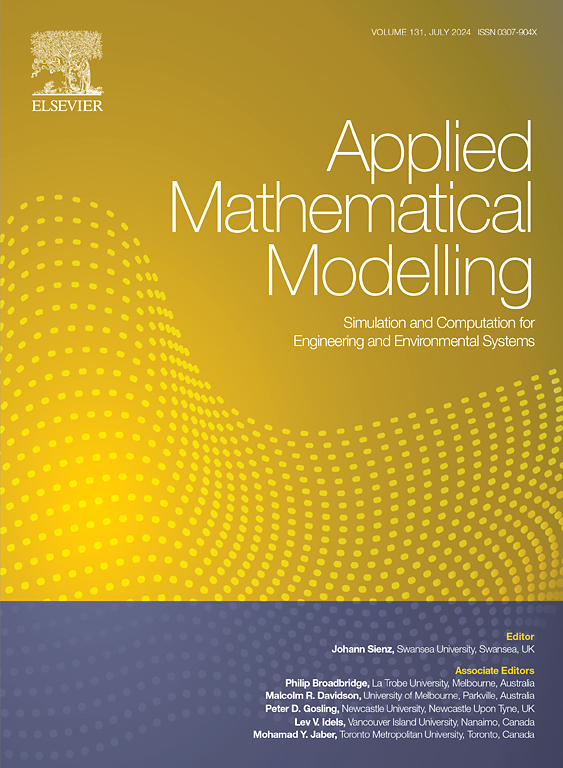l 形弯曲扭转压电能量采集系统的机电模型
IF 4.4
2区 工程技术
Q1 ENGINEERING, MULTIDISCIPLINARY
引用次数: 0
摘要
近年来,压电能量采集(PEH)已成为一个重要概念,其目的是从各种机械振动中采集能量。然而,在压电能量收集的多模态和多方向分析方面还存在很大差距。在此背景下,本文提出了一种创新方法,即引入一种新型多模态和多方向 PEH 设计,同时利用面伸展模式(d31)和面剪切模式(d36),以低频环境为目标。研究调查了三种弯曲-扭转 l 形双态 PEH,即 H1、H2 和 H3。为了评估所提出的 PEH 的性能,根据欧拉-伯努利梁假设建立了分布参数模型。该模型的有效性得到了之前工作中的分析、数值和实验结果的证实。利用 d36 模式可使 H1、H2 和 H3 的功率输出分别提高 67.95%、43.66% 和 31.83%。对三种 PEH 的性能进行了定量和定性比较,发现 H1 是其中效率最高的。PEH H1 只需单次激励即可完成弯曲-扭转耦合运动,因此平均功率输出高达 54.66 µW,是其他两种 PEH 的十倍。利用 d36 模式扩大频率带宽并提高功率输出,为压电能量收集带来了极佳的创新和实用价值。本文章由计算机程序翻译,如有差异,请以英文原文为准。
Electromechanical modelling of l-shaped bending-torsion piezoelectric energy harvesting systems
Piezoelectric energy harvesting (PEH) has become an important concept in recent years, aiming to harvest energy from various mechanical vibrations. However, a significant gap has been noticed in the multimodal and multidirectional analytics of PEHs. In this context, this paper proposes an innovative approach to introduce a novel multimodal and multidirectional PEH design, which exploits both the face extension mode (d31) and the face shear mode (d36), to target low-frequency environments. The study investigates three bending-torsion l-shaped bimorph PEHs, namely H1, H2, and H3. To evaluate the performance of the proposed PEHs, a distributed parameter model is developed based on the assumptions of the Euler-Bernoulli beam. The validity of the model is confirmed by analytical, numerical, and experimental results from previous work. The exploitation of the d36 mode enhances the power output of H1, H2, and H3 by 67.95 %, 43.66 %, and 31.83 respectively. The three PEHs performances are compared quantitatively and qualitatively, and H1 is found to be the most efficient among them. The PEH H1 requires a single excitation to perform the coupled bending-torsion motions, resulting in an outstanding average power output of 54.66 µW, which outperforms the other two PEHs by tenfold. The use of the d36 modes to expand the frequency bandwidth and improve the power output presents an excellent innovative and practical value for piezoelectric energy harvesting.
求助全文
通过发布文献求助,成功后即可免费获取论文全文。
去求助
来源期刊

Applied Mathematical Modelling
数学-工程:综合
CiteScore
9.80
自引率
8.00%
发文量
508
审稿时长
43 days
期刊介绍:
Applied Mathematical Modelling focuses on research related to the mathematical modelling of engineering and environmental processes, manufacturing, and industrial systems. A significant emerging area of research activity involves multiphysics processes, and contributions in this area are particularly encouraged.
This influential publication covers a wide spectrum of subjects including heat transfer, fluid mechanics, CFD, and transport phenomena; solid mechanics and mechanics of metals; electromagnets and MHD; reliability modelling and system optimization; finite volume, finite element, and boundary element procedures; modelling of inventory, industrial, manufacturing and logistics systems for viable decision making; civil engineering systems and structures; mineral and energy resources; relevant software engineering issues associated with CAD and CAE; and materials and metallurgical engineering.
Applied Mathematical Modelling is primarily interested in papers developing increased insights into real-world problems through novel mathematical modelling, novel applications or a combination of these. Papers employing existing numerical techniques must demonstrate sufficient novelty in the solution of practical problems. Papers on fuzzy logic in decision-making or purely financial mathematics are normally not considered. Research on fractional differential equations, bifurcation, and numerical methods needs to include practical examples. Population dynamics must solve realistic scenarios. Papers in the area of logistics and business modelling should demonstrate meaningful managerial insight. Submissions with no real-world application will not be considered.
 求助内容:
求助内容: 应助结果提醒方式:
应助结果提醒方式:


